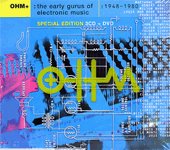

 |
 |
 |
This Week's
|
Friday, January 06, 2006
Of Interest?  Pitchfork reviews OHM+: Early Gurus of Electronic Music: 1948 - 1980/Various Artists. Sounds very much like it might be of interest to some of S21s readers and contributors. Here're a couple of paragraphs: Lucky for us, three generations into the technological revolution, much of the shock of innovation has given way to something of a learned instinct when it comes to this stuff. The groundbreaking experiments of composers like Karlheinz Stockhausen, Pierre Schaefer, Pierre Henry, and John Cage have led to an age where blips and beeps are not only taken for granted but form the basis of a musical education that for most people starts in pre-school with such "advanced" learning tools as Simon Says. OHM+, covering electronic music from the 1930s to the 1980s, documents a clear and steady path towards an age when most music simply couldn't be made without electronic assistance. The characters involved were undoubtedly experimenters working on the edges of both technology and good old human ingenuity. In many cases, their results will sound strange to ears accustomed to more refined uses of the available tools-- but in others, the sounds are eerily ahead of their time. Regardless, OHM+ is one of the best documents of its kind, and a model for archival compilations.and Of course, there is plenty of the hard stuff: check the animated audience reaction to Cage's revolutionary tape-edit piece Williams Mix from 1952, or Tod Dockstader's creepy sound collage "Apocalypse II" from 1961. Stockhausen predates both surround sound and Zaireeka with his four-channel Kontakte, while Edgard Varese's "Poem Electronique", using seemingly random snippets of found-sound and ancient synthesizer squeaks, is actually one of the great early examples of mastering electronic music bit by bit. And if you're left wanting some good old fashioned humanity, Milton Babbit's Philomel excerpt, a duet of sorts featuring synthesizer and female soprano, forecasts just how integrated electronics would become with live performance.The playlist can be viewed here. Lots of names I know (Sonic Youth!), lots of names I recognize from discussions I've read on S21, lots of names unfamiliar. Sounds like a compilation worth owning, and luckily I've got gift cards from festivus burning a hole in my wallet. Should I buy it? If no, what instead? bLCkdgRd |